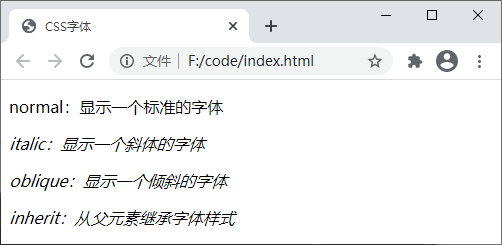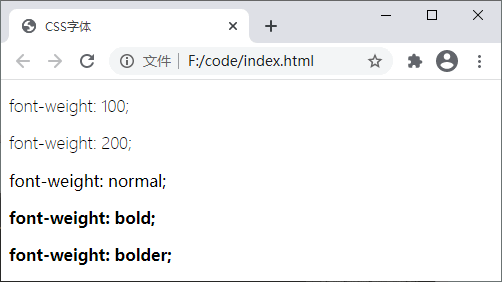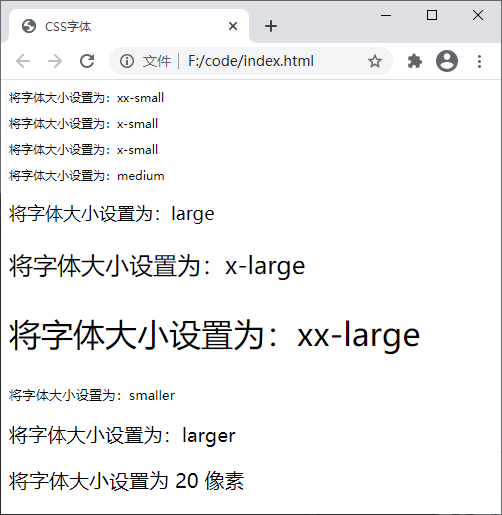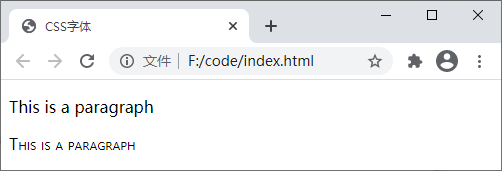,分隔,浏览器会首先尝试列表中的第一个字体,如果不支持则尝试下一个,以此类推。| 值 | 描述 |
|---|---|
|
family-name、 generic-family |
family-name:字体名称,一个字体名称就代表一种字体,比如“微软雅黑”就是一种字体; generic-family:字体族,也就是某种类型的字体组合,一个字体族代表一种类型的字体,其中包含很多相似但又不同的字体,比如“sans-serif”就是一种无衬线字体,其中包含很多种相似的字体。 字体的默认值取决于浏览器设置 |
| inherit | 从父元素继承字体的设置 |
| 字体族 | 说明 | 字体 |
|---|---|---|
| serif | 有衬线字体,即在文字笔画的结尾添加特殊的装饰线或衬线 | "Lucida Bright"、"Lucida Fax"、Palatino、"Palatino Linotype"、Palladio、"URW Palladio"、serif |
| sans-serif | 无衬线字体,即在文字笔画结尾处是平滑的 | "Open Sans"、"Fira Sans"、"Lucida Sans"、"Lucida Sans Unicode"、"Trebuchet MS"、"Liberation Sans"、"Nimbus Sans L"、sans-serif |
| monospace | 等宽字体,即每个文字的宽度都是相同的 | "Fira Mono"、"DejaVu Sans Mono"、Menlo、Consolas、"Liberation Mono"、Monaco、"Lucida Console"、monospace |
| cursive | 草书字体,该字体有连笔或者特殊的斜体效果,会给人一种手写的感觉 | "Brush Script MT"、"Brush Script Std"、"Lucida Calligraphy"、"Lucida Handwriting"、"Apple Chancery"、cursive |
| fantasy | 具有特殊艺术效果的字体 | Papyrus、Herculanum、"Party LET"、"Curlz MT"、Harrington、fantasy |
<!DOCTYPE html>
<html>
<head>
<title>CSS字体</title>
<style>
body {
font-family: "Lucida Calligraphy", cursive, serif, sans-serif;
}
</style>
</head>
<body>
<h1>font-family 属性</h1>
</body>
</html>
运行结果如下图所示:

图:font-family 属性演示
注意:如果字体族或字体名称中包含空格或多个单词,则必须将它们使用引号包裹起来,例如"Times New Roman"、"Courier New"、"Segoe UI" 等,如果是在元素的 style 属性中使用则必须使用单引号。
在网页设计中最常用的字体族是 serif 和 sans-serif,因为它们适合阅读。在显示一些程序代码是通常使用等宽字体,这样可以使用程序代码看起来更加工整。| 值 | 描述 |
|---|---|
| normal | 默认值,文本以正常字体显示 |
| italic | 文本以斜体显示 |
| oblique | 文本倾斜显示 |
| inherit | 从父元素继承字体样式 |
<!DOCTYPE html>
<html>
<head>
<title>CSS字体</title>
<style>
body {
font-style: oblique;
}
.normal {
font-style: normal;
}
.italic {
font-style: italic;
}
.oblique {
font-style: oblique;
}
.inherit {
font-style: inherit;
}
</style>
</head>
<body>
<p class="normal">normal:显示一个标准的字体</p>
<p class="italic">italic:显示一个斜体的字体</p>
<p class="oblique">oblique:显示一个倾斜的字体</p>
<p class="inherit">inherit:从父元素继承字体样式</p>
</body>
</html>
运行结果如下图所示:

图:font-style 属性演示
| 值 | 描述 |
|---|---|
| normal | 默认值,标准字体 |
| bold | 粗体字体 |
| bolder | 更粗的字体 |
| lighter | 更细的字体 |
| 100、200、300、400、500、600、700、800、900 | 由细到粗的设置字体粗细,100 为最细的字体,400 等同于 normal,700 等同于 bold |
| inherit | 从父元素继承字体的粗细 |
<!DOCTYPE html>
<html>
<head>
<title>CSS字体</title>
<style>
p.weight-100 {
font-weight: 100;
}
p.weight-200 {
font-weight: 200;
}
p.normal {
font-weight: normal;
}
p.bold {
font-weight: bold;
}
p.bolder {
font-weight: bolder;
}
</style>
</head>
<body>
<p class="weight-100">font-weight: 100;</p>
<p class="weight-200">font-weight: 200;</p>
<p class="normal">font-weight: normal;</p>
<p class="bold">font-weight: bold;</p>
<p class="bolder">font-weight: bolder;</p>
</body>
</html>
运行结果如下图所示:

图:font-weight 属性演示
| 值 | 描述 |
|---|---|
| xx-small、x-small、small、medium、large、x-large、xx-large | 以关键字的形式把字体设置为不同的大小,从 xx-small 到 xx-large 依次变大,默认值为 medium |
| smaller | 为字体设置一个比父元素更小的尺寸 |
| larger | 为字体设置一个比父元素更大的尺寸 |
| length | 以数值加单位的形式把字体设置为一个固定尺寸,例如 18px、2em |
| % | 以百分比的形式为字体设置一个相对于父元素字体的大小 |
| inherit | 从父元素继承字体的尺寸 |
<!DOCTYPE html>
<html>
<head>
<title>CSS字体</title>
<style>
.xx_small {
font-size: xx-small;
}
.x_small {
font-size: x-small;
}
.small {
font-size: x-small;
}
.medium {
font-size: x-small;
}
.large {
font-size: large;
}
.x-large {
font-size: x-large;
}
.xx-large {
font-size: xx-large;
}
.smaller {
font-size: smaller;
}
.larger {
font-size: larger;
}
.font-20 {
font-size: 20px;
}
</style>
</head>
<body>
<p class="xx_small">将字体大小设置为:xx-small</p>
<p class="x_small">将字体大小设置为:x-small</p>
<p class="small">将字体大小设置为:x-small</p>
<p class="medium">将字体大小设置为:medium</p>
<p class="large">将字体大小设置为:large</p>
<p class="x-large">将字体大小设置为:x-large</p>
<p class="xx-large">将字体大小设置为:xx-large</p>
<p class="smaller">将字体大小设置为:smaller</p>
<p class="larger">将字体大小设置为:larger</p>
<p class="font-20">将字体大小设置为 20 像素</p>
</body>
</html>
运行结果如下图所示:

图:font-size 属性演示
| 值 | 描述 |
|---|---|
| normal | 默认值,浏览器会显示一个标准的字体 |
| small-caps | 将文本中的小写英文字母转换为小型大写字母 |
| inherit | 从父元素继承 font-variant 属性的值 |
<!DOCTYPE html>
<html>
<head>
<title>CSS字体</title>
<style>
.normal {
font-variant: normal
}
.small {
font-variant: small-caps
}
</style>
</head>
<body>
<p class="normal">This is a paragraph</p>
<p class="small">This is a paragraph</p>
</body>
</html>
运行结果如下图所示:

图:font-variant 属性演示
font:[[font-style||font-variant||font-weight||font-stretch]?font-size[ /line-height]?font-family] | caption | icon | menu | message-box | small-caption | status-bar
在使用 font 属性时,有以下几点需要注意:/将 font-size 和 line-height 属性分开。
<!DOCTYPE html>
<html>
<head>
<title>CSS字体</title>
<style>
p.info {
font: italic bold 12px/30px arial, sans-serif;
}
</style>
</head>
<body>
<p>使用 font 属性需要遵循以下顺序:</p>
<p class="info">font:[[font-style||font-variant||font-weight||font-stretch]?font-size[ /line-height]?font-family] | caption | icon | menu | message-box | small-caption | status-bar</p>
</body>
</html>
运行结果如下图所示:

图:font 属性演示
本文链接:http://task.lmcjl.com/news/14553.html